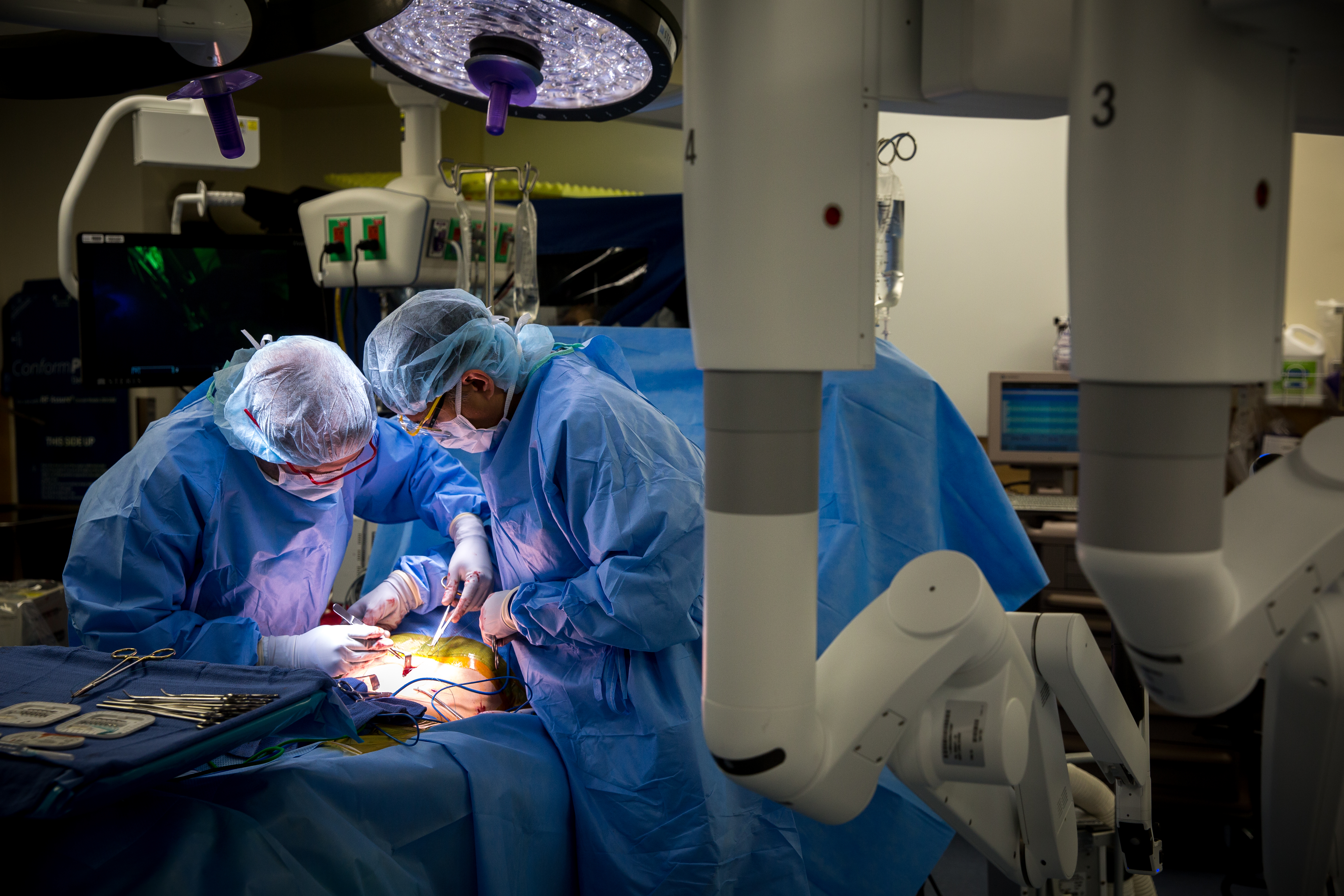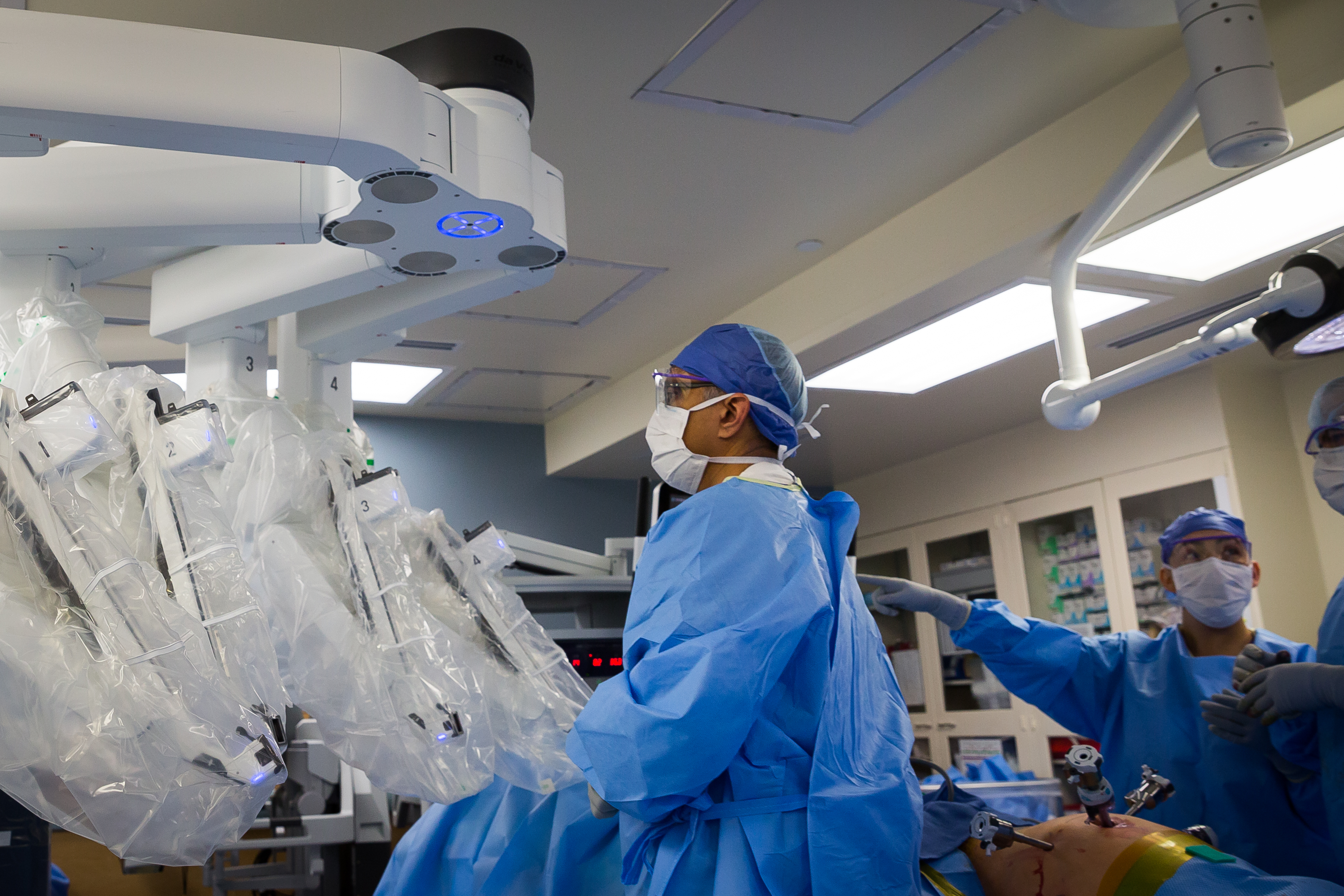Program Provides Research Opportunities for Undergraduate Students

Time-Tested Technology
UNM’s Robotic Surgery Program Reaches 10-Year Milestone
The deeply anesthetized patient lies supine on the operating table, tubular steel ports protruding from small incisions in his belly, which has been distended with carbon dioxide to make it taut as a drum.
Four jointed arms hovering overhead connect to slender probes that extend down through the ports into his abdomen, where tiny instruments are snipping, cauterizing and burrowing their way toward the man's cancerous prostate.
Urologist Satyan Shah, MD, perches at a console controlling the DaVinci robot a few feet away, eyes glued to a stereoscopic eyepiece that provides a 3-D view of the complex anatomy he is navigating. His thumbs and forefingers slip into loops that guide the movement of the tools inside the patient's body, while foot pedals control the magnification and lighting of the camera.
"We're separating between the bladder and the rectum," he announces to Brad Webster, MD, a third-year urological resident who sits at an identical console nearby, intently watching Shah's confident manipulation of the instruments. "We have to take down quite a number of structures before we can even get to the prostate."
Shah's laid-back manner is underscored by the comfortable black slippers he wears, the better to control the foot pedals. "I used to wear socks," he confides.
It's little wonder that Shah feels so at home working with the robot. He has performed more than 500 procedures since he introduced robotic surgery to UNM Hospital in 2008.
A decade after installing the first surgical robot (dubbed "Smarty the Robot" by patients at UNM Children's Hospital), the hospital now has two more-advanced models. The devices have been used in general and cardiothoracic surgery, ENT procedures, surgical oncology, neurosurgery and pediatric surgery.
Shah's enthusiasm for the use of the robot - especially in cases where there isn't much room to maneuver - is undisguised. One implement can be used to push tissue aside to make room for the others to cut, cauterize or suture, he points out. "It's like having an assistant built in," he says. "You're actually a four-armed surgeon."
Better still, there's no tremor. "When you make a large movement in the console, it translates into a tiny movement," he says.
"When a layperson hears 'robotic surgery,' they think, 'Oh my god, R2D2 is going to be doing my surgery,'" Shah says. "It's a little bit of a misnomer." In reality, the robot simply translates the surgeon's finger movements with great precision while offering 10-fold magnification and greater range of motion than is possible with conventional surgery.
In the OR, Shah points out that the robotically guided instruments have a built-in "memory." Each time surgical tech Chantel Davila extracts an instrument from a port, its replacement slides in to exactly the same location. When she inserts a tiny curved needle through the port, Shah hands over the controls to Webster so the resident can tie a couple of sutures.
The man on the table has been Shah's patient for some time. "He has a very aggressive cancer," Shah says. "We tried to watch it, but his PSAs just kept going up and up." Regaining the controls from Webster, he works carefully to detach the prostate from the surrounding tissue. Three hours into the operation, he's done. "All right, totally free," he announces.
Guiding tiny pincers, he carefully transfers the prostate into a small plastic bag that has been inserted into the abdominal cavity and pulls it closed with a drawstring. "We'll leave this specimen until the end of the surgery," Shah says. "Then we'll grab it by the string and pull it right out."
After Albuquerque businessman Ronald Young was diagnosed with an aggressive form of prostate cancer in 2009 he did his own research and decided robotic surgery made the most sense. That's when he went to see Shah.
"What I really liked about the robotic surgery option is that it left you a second course of care, in case something didn't go right," he says. The surgery went smoothly and Young was up on his feet and walking around the same day. All the credit goes to Shah, he says.
"I basically owe my life to the man," he says. "I'm very, very, very pleased. I'm a big supporter and glad to talk to other men facing that option."
Shah says that while robotic procedures take somewhat longer than open surgeries, patients who go that route tend to have shorter hospitalizations, experience fewer complications and lose less blood.
Another advantage is that robotic surgery lends itself to teaching, because both surgeons have a clear view of the procedure. "In open surgery, though we're both looking in there, the working area is so small, there's only room for one person to see," he says.
Webster agrees. "You can't beat the anatomy you can see with this," he says. "The nice thing about it is as you're doing it you have somebody who's done hundreds of these who can take control of it at any time."
Still, he acknowledges professional opinions differ about whether robotic prostatectomies are better than the traditional open or laparoscopic surgery. "It's an open area of debate among urologists," he says. "I think the pendulum goes back and forth."
Shah, 41, grew up in Syracuse, N.Y., where he developed an early interest in medicine.
"I just had a personal appreciation for the service that physicians do - the care that they take and what they provide the patient and that bond that forms," he says. "I had seen people in my own family who had gone through illness and established that type of bond. I was clearly attracted to medicine for that."
As a youngster, he was a dedicated karate student, eventually earning his black belt. "This was the days of the Karate Kid - that was what sparked my interest in it," he says. "I was encouraged by my parents. I think they innately realized this was more than exercise. There were character-building traits that these guys were teaching."
Shah graduated at the top of his class at the Robert Wood Johnson Medical School in New Jersey and was elected to the Alpha Omega Alpha Honor Society. He arrived at UNM after completing a five-year urology residency at Loma Linda University Medical Center in California and a one-year fellowship at the Roswell Park Cancer Institute in New York.
"That was the time when people were getting interested in robotics in urology," he says. "It was there that I first saw the technology and I quickly became enthralled with it and decided this is what I wanted to spend my career on."
Back in the OR, Shah patiently starts to suture the anastomosis that will connect the urethra directly to the bladder. Following his instructions, Davila gently pushes a Foley catheter through the exposed end of the urethra just enough to allow him to grasp its outer edge with a jawed tool while he inserts and draws through the needle with another implement.
When the suturing is complete, Shah asks Davila to inflate the catheter so that it expands the bladder like a balloon. "No fluid leaked out, so we've got a nice, watertight connection," he says, satisfied.
Now, the boom from which the robotic arms are suspended is wheeled back to allow Shah and Webster to install a drain, release the CO2 and extract the ports. Shah uses a scalpel to widen one incision so that Webster can fish out the bag containing the prostate.
They cut it open and pull out a mass of dense tissue the size and color of a plum (a normal prostate is the size of a walnut).
The pair start methodically stitching up the layers of fascia beneath the skin to prevent hernia, then finish suturing the incision. The anesthesiologist dials back the gas that has kept the man sound asleep, and he starts to stir.
"He'll be walking by this evening," Shah says. "By this weekend, I predict he'll just be on Tylenol."
The patient is transferred to a gurney and wheeled off to recovery. The process of preparing the robot and OR for the next procedure is already underway.

